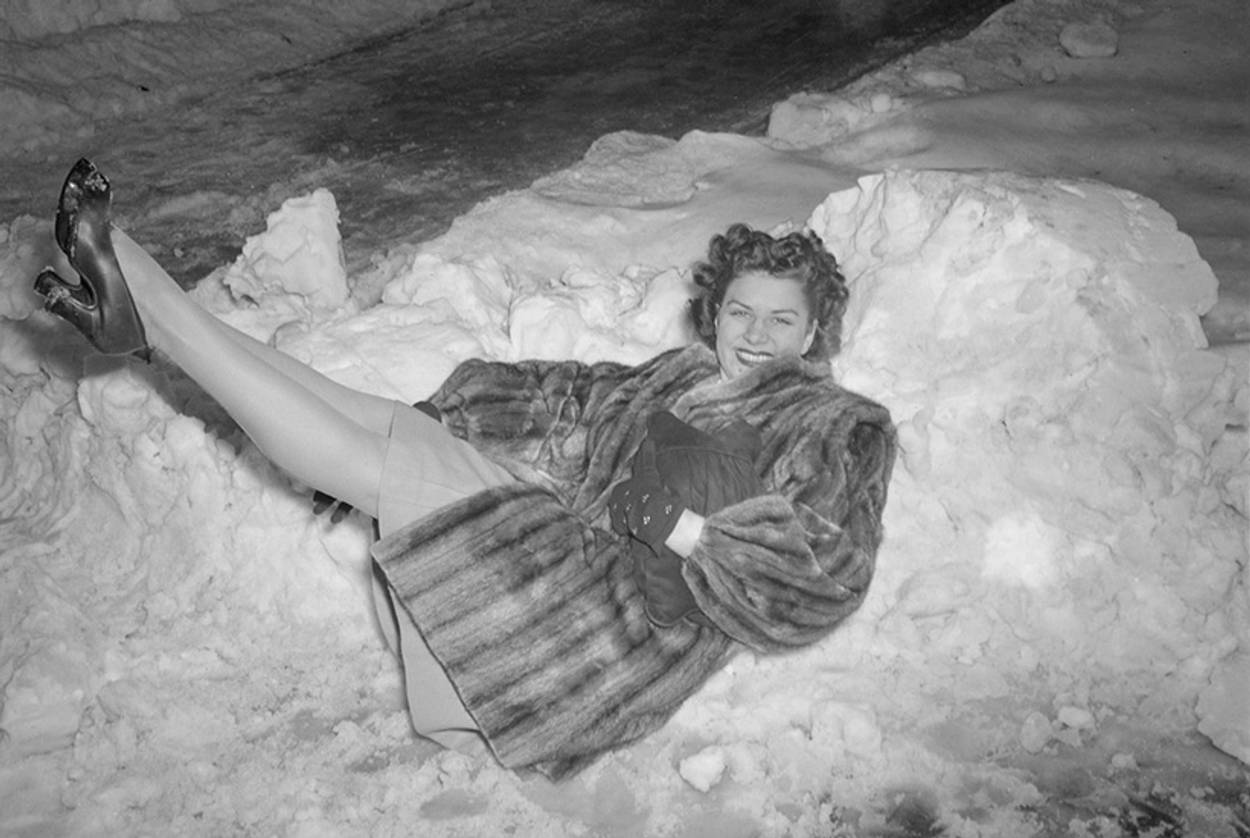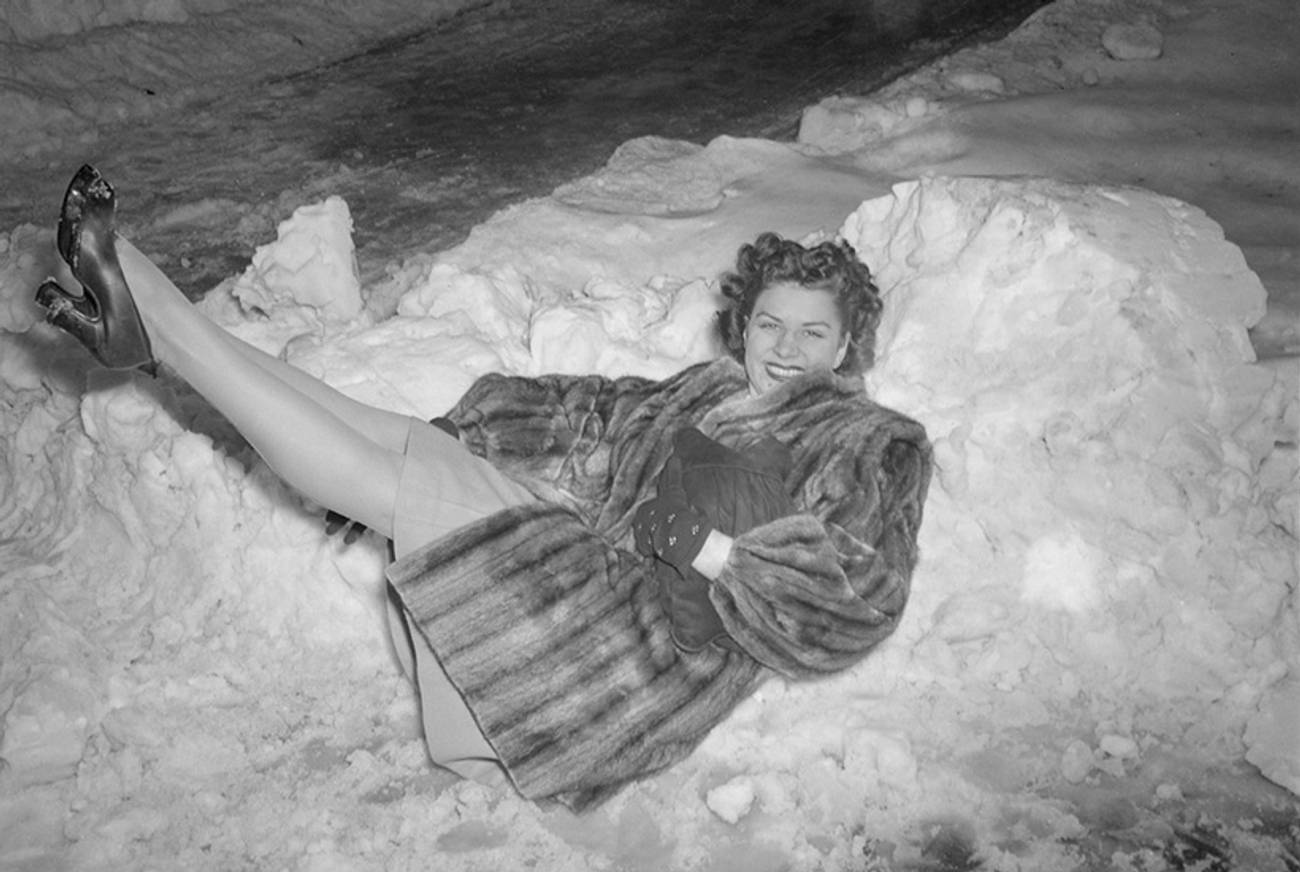‘Tznius’ in Furs: What Judaism Has To Say About My Mink Coat
How can we square conspicuous extravagance with laws of modesty? What about Jewish laws about treating animals humanely?




I wear a fur coat. This winter has been vicious in New York, and the coat is the warmest thing I own. When I put my hands in the pockets, I always do a double-take—the pockets are lined with the softest velvet, like a delicious secret. Every time I leave the house I’m afraid someone will throw paint on me, but I wear the coat anyway.
It’s vintage, which allows me to tell myself I didn’t personally cause the agonizing deaths of furry animals. It looks like an artifact from the set of Dynasty: a full-length mink with puffed shoulders and a little stand-up collar. It has a rip in the back and one at the hip, showing some of the lining. I tell myself this looks punk rock. I tell myself that telling oneself that mink looks punk rock is really punk rock.
My other coats are vintage too, if not nearly so fancypants: a leopard-print faux fur bought in 1993 from the sadly defunct Love Saves the Day (the funky thrift shop immortalized by Madonna in Desperately Seeking Susan) on Second Avenue, a black velvet swing coat from the moved-to-Cleveland Re/Dress in Brooklyn, a purple-and-blue tweed coat from a wonderful poet friend in San Francisco who died too young from breast cancer in 2006. Only my practical parka from Lands End has no history, and I hate that boring, utilitarian thing with a flaming passion.
The fur coat belonged to a woman named Wendie. She was my uncle Joel’s first wife, by all accounts a warm, lovely person and a devoted mom until she died in 1988 and left two small children behind. Two years later, Joel married my father’s sister Nancy, who was also widowed far too young and also had two young kids. I did not know Wendie, and if Wendie had lived, I wouldn’t have known Joel. But she died, and I do.
I have nothing but admiration for the way Joel and Nancy have blended their families. The siblings are all in their 30s now, all close. Every year, spurred by my cousin Stefanie, they do a fundraising walk for ovarian cancer research in Wendie’s memory. As a teenager, Stef was rabidly anti-fur, and she didn’t want the coat. Nancy and Joel offered it to me. I was in my 20s. I was honored, despite my fear of the paint-throwers. Because not only was it tied to family and community, it was old. I liked that it looked dated; I liked that it had a past.
I am aware that making a distinction between new and old fur is nearly literally splitting hairs. But then and now, even as I step out in my vintage mink, I judge people in new furs. I think their values are skewed and their taste is questionable.
My anti-fur bias (however internally contradictory) hasn’t historically been shared by my fellow yehudim. Back in the 18th century in Eastern Europe, Jews dominated the fur trade, and in the new country Jews viewed fur as a symbol of having arrived.
“Transcending the circumstances of its birth, a fur coat symbolized America’s bounty and beauty,” writes Jenna Weissman Joselit in A Perfect Fit: Clothes, Character, and the Promise of America. “A fur coat bore witness to the promise of America. In homes across the nation, especially those inhabited by immigrants and their children, the purchase of a fur coat was experienced not as a failure of will or as a sign of moral turpitude. It was experienced as a triumph and a vindication, as material evidence of America’s blessings.”
Joselit, director of the program in Judaic Studies at George Washington University, notes that in the early 20th century, furs started becoming more accessible to working (new) Americans. “No longer the exclusive preserve of the wealthy or an heirloom passed down from one generation to the next, a fur coat was now available to the many,” she writes. “Mink, sable, and silver fox still remained outside the realm of possibility for everyone but the moneyed elite. … But coats fashioned out of muskrat, rabbit, and squirrel skins and ranging in price from under $100 to a high of $250 were well within reach of the aspiring middle class. The wearing of fur, the New York Times reported in 1924, had ‘become universal in all classes of society.’ ”
In an interview, Joselit noted: “Pre-1960s, I’d say, owning a fur was a collective aspiration of American Jewish women. It was a visible testament to economic success. And a nice warm one at that! I remember when my dad gave my mom a fur. Somebody knew somebody, and it came in this dull brown box. But when my mother unwrapped it, it was a marvelous mink with a green lining. And everyone was so proud! There was no thought to how incorrect it was! What a wonderful symbol of America’s bounty! And how pretty she looked!”
I asked Joselit whether there was historically any anti-fur sentiment in the American Jewish community, and she hesitated. “Maybe in more left-wing socialist circles … but then again, a lot of those guys were in fur unions. And the fur union was very, very left. In the garment center fur wasn’t seen as an exotic import but something necessary to one’s bread and butter. And of course, fur accrues all sorts of other meanings—it’s a visible salute to America, and I don’t mean that in a snarky way. It was bound up with going to shul and the High Holidays—I wouldn’t go so far as to say that association douses it with sanctity, but fur is part of the ritual economy. It became such a part of the culture it lent itself to joking about Jewish women wearing furs in 90-degree weather.”
Today, though, more folks are worried about issues of provenance and ethics surrounding fur. Maybe we’re less concerned about showing we’ve made it and more concerned about the costs (to our fellow mammals and to our own values) of getting there. Maybe, too, Jews are worried about looking too flashy or tacky. Furs are fine for Joe Namath, but mere mortals are worried about being mocked. And who wants to make our fuzzy friends suffer?
Judaism’s attitude toward fur is generally covered by the rules about tza’ar baalei chaim—animal suffering. We understand that animals feel pain and that we have an obligation toward them. We’re obliged to feed our animals before we feed ourselves. Kosher slaughter is supposed to kill an animal painlessly, with one clean cut delivered by a super-sharp blade. But most authorities say it’s fine to wear leather, and most feel that fur is OK, too. At Aish HaTorah, the Ask the Ethicist columnist, Rabbi Dr. Asher Meir, the research director at the Business Ethics Center of Jerusalem, writes that fur would be bad if your purpose in wearing it were to make others feel inferior. But otherwise, “furs are no more conspicuous or luxurious than a great many creature comforts that a few people enjoy and a great many other people wish they could. Five-figure mink stoles are not the mainstay of the fur industry; inexpensive winter jackets trimmed with rabbit fur are far more common. And there are plenty of leather goods which are no less luxurious.”
On the Lower East Side, most of the fur I see is on Orthodox women. Rabbi Shmuley Boteach is scornful of religious women in fur, writing about how after spending a decade in England, he was shocked to experience “the blizzard of fur coats in New York and New Jersey.” But in America, he writes in The Jewish Press, “the fur coat is to women what the Ferrari has always been to men—the ultimate statement of high-flying, material success.” One might think women would be above flaunting the accouterments of success the way men do, since “we always believed that women were more mature and could rise above the insecurities that have often made men so ridiculous.” But no! And yet, he continues, “I am not judging the fine women of my neighborhood, many of whom lead lives of exceptional generosity and humility, for wearing a rare species as a second skin. We all like nice things, and we all like to occasionally make an impression. And who am I to judge when throughout my life I have also battled my own materialistic inclination, not to mention my own shallow need to impress? My point, rather, is this: If the lust for materialism in the Jewish community is even beginning to corrupt our women, then it’s time to wake up and smell the money.” (Whew, not too many backhanded compliments, equivocating, or sexism there. Then again, in a column full of my own contradictions, who am I to talk?) Perhaps, Boteach implies, we were better off as a people when we were poorer and more persecuted. “It turns out that money is even more corrosive than poverty, and living on the Upper East Side of Manhattan can be more injurious to one’s soul than living in a ghetto,” he concludes.
I might not go that far. One has the luxury of worrying about the impact of luxury goods on one’s soul when one is not worried about the impact of Cossacks and Nazis on one’s neck.
But there’s a strange contradiction between the laws of tzniut (or tznius), modesty, and the prevalence of fur in the religious community. If you literally believe in the laws of tzniut, how do you square those beliefs with gazillion-dollar golden wigs, long-but-tight sexy-librarian dresses, and schmancy furs? Isn’t the mere act of flaunting your dominion over the rest of God’s creatures inherently immodest? And what of the fur on religious men’s Shabbos hats? Isn’t that a wee bit unnecessarily superfly?
An ultra-Orthodox rabbi in Jerusalem says yes. Last year, the influential Rabbi Shlomo Pappenheim announced that fur shtreimels violate the laws of tza’ar baalei chaim, and wearing one is a desecration of God’s name. Artificial fur, he said, should do fine.
Among the non-Orthodox, statement fur—whether in a ritual or fashion context—is less common than it was a few decades ago. My former colleague at Sassy, fashion icon Andrea Linett, points out that while fur has always been a symbol of “arriving” and a powerful lure for immigrants of all stripes, lower-key, more playful fur (often from less expensive pelts, like rabbit) holds sway among young fashion-conscious shoppers. And Joselit points out that vintage fur (in the form of shrugs, jackets, or fur-trimmed cardigans) “is knowing and ironic, compared to going to someplace like J. Mendel and buying an important fur.” For younger consumers, fur goes with either wink or a wince. “But for their parents and grandparents,” Joselit points out, “fur was deadly serious.”
***
Like this article? Sign up for our Daily Digest to get Tablet Magazine’s new content in your inbox each morning.
Marjorie Ingall is a columnist for Tablet Magazine, and author of Mamaleh Knows Best: What Jewish Mothers Do to Raise Successful, Creative, Empathetic, Independent Children.
Marjorie Ingall is a former columnist for Tablet, the author of Mamaleh Knows Best, and a frequent contributor to the New York Times Book Review.